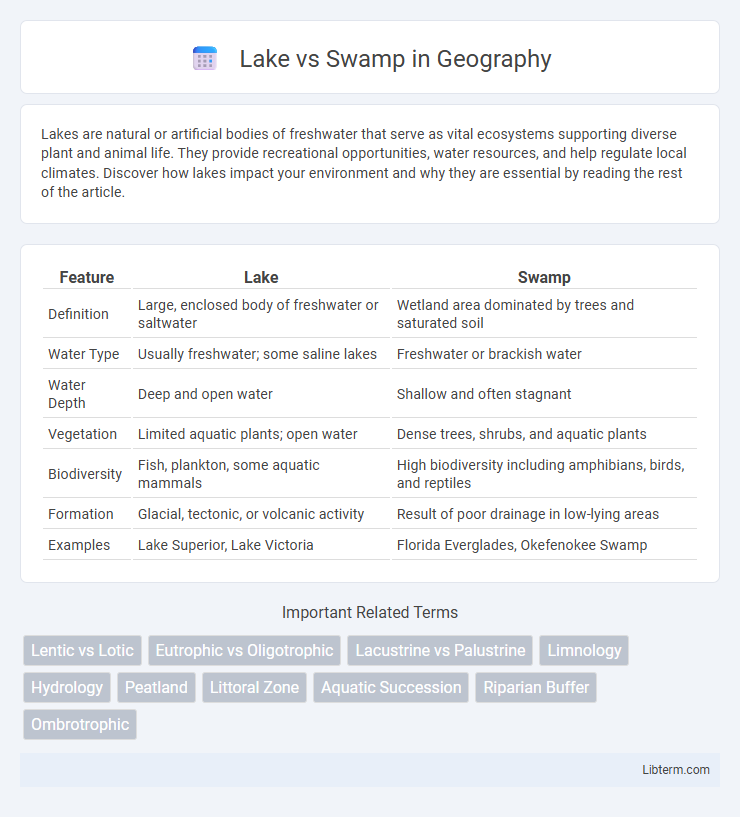Lakes are natural or artificial bodies of freshwater that serve as vital ecosystems supporting diverse plant and animal life. They provide recreational opportunities, water resources, and help regulate local climates. Discover how lakes impact your environment and why they are essential by reading the rest of the article.
Table of Comparison
| Feature | Lake | Swamp |
|---|---|---|
| Definition | Large, enclosed body of freshwater or saltwater | Wetland area dominated by trees and saturated soil |
| Water Type | Usually freshwater; some saline lakes | Freshwater or brackish water |
| Water Depth | Deep and open water | Shallow and often stagnant |
| Vegetation | Limited aquatic plants; open water | Dense trees, shrubs, and aquatic plants |
| Biodiversity | Fish, plankton, some aquatic mammals | High biodiversity including amphibians, birds, and reptiles |
| Formation | Glacial, tectonic, or volcanic activity | Result of poor drainage in low-lying areas |
| Examples | Lake Superior, Lake Victoria | Florida Everglades, Okefenokee Swamp |
Defining Lakes and Swamps
Lakes are large, inland bodies of standing freshwater or saltwater, typically deeper and more permanent, with well-defined shorelines and clear stratification of water layers. Swamps are wetlands characterized by saturated soils and abundant woody vegetation, often featuring slow-moving or stagnant water with diverse ecosystems adapted to wet conditions. Both play crucial roles in hydrology and biodiversity, but lakes primarily serve as reservoirs, while swamps function as natural water filters and wildlife habitats.
Formation Processes: How Lakes and Swamps Are Created
Lakes form through geological processes such as tectonic activity, glacial movements, volcanic craters, or river oxbow cutoffs that create basins capable of holding standing water. Swamps develop primarily in low-lying areas where poor drainage allows water to accumulate over time, supporting dense vegetation and saturated soil conditions. The key difference in formation lies in lakes being deep water bodies often created by physical ground shifts, while swamps result from persistent flooding and organic matter buildup in wetlands.
Key Physical Differences
Lakes are large, deep bodies of standing freshwater with clear boundaries and stratified water layers, typically supporting diverse aquatic life. Swamps are shallow wetlands characterized by saturated soils, abundant vegetation like trees and shrubs, and slower water flow, often serving as critical habitats for amphibians and birds. The key physical differences include depth, water clarity, and dominant vegetation, with lakes having open water and swamps dominated by plant growth.
Water Quality and Composition
Lakes typically contain clearer, oxygen-rich water supporting diverse aquatic life, with stratified layers influencing nutrient distribution and temperature. Swamps have murkier, nutrient-rich, and often low-oxygen water due to decaying vegetation, promoting anaerobic conditions and unique ecosystems adapted to such environments. Water composition in lakes favors aerobic organisms, while swamp conditions support specialized flora and fauna adapted to fluctuating water quality and high organic content.
Biodiversity and Ecosystems
Lakes support diverse aquatic ecosystems with stratified habitats that sustain fish, amphibians, and aquatic plants, promoting high biodiversity in stable water conditions. Swamps feature saturated soils and dense vegetation, such as trees and shrubs, creating complex habitats that support diverse wildlife including migratory birds, amphibians, and insects. Both ecosystems play critical roles in nutrient cycling and water filtration but differ in hydrology and species composition, contributing uniquely to regional biodiversity.
Human Interaction and Uses
Lakes serve as vital sources for drinking water, recreation, and hydroelectric power generation, supporting fishing industries and tourism that boost local economies. Swamps, rich in biodiversity and natural filtration systems, provide communities with resources such as timber, medicinal plants, and harvestable fish and game, while also acting as natural flood control and carbon sinks. Human interaction with both ecosystems requires sustainable management practices to balance resource use with conservation and minimize environmental degradation.
Role in Climate and Water Cycle
Lakes serve as significant freshwater reservoirs that regulate local climates by storing heat and influencing atmospheric moisture through evaporation. Swamps play a critical role in carbon sequestration by trapping organic matter and mitigating greenhouse gas emissions while acting as natural water filters and flood buffers. Both ecosystems contribute to the water cycle by facilitating groundwater recharge, supporting biodiversity, and maintaining hydrological balance in their regions.
Common Flora and Fauna
Lakes typically support aquatic plants like water lilies, cattails, and submerged vegetation such as pondweeds, while their fauna includes fish species like bass and trout, amphibians, and waterfowl. Swamps are dominated by woody vegetation like cypress and mangroves, with fauna including alligators, amphibians, insects, and diverse bird species adapted to wetland environments. Both ecosystems are critical habitats supporting biodiversity, but swamps have denser vegetation and more specialized species adapted to saturated soils and standing water.
Environmental Challenges and Conservation
Lakes face environmental challenges such as eutrophication, invasive species, and pollution, which impact water quality and aquatic biodiversity. Swamps struggle with habitat loss, altered hydrology, and contamination from agricultural runoff, threatening unique wetland ecosystems. Conservation efforts for both focus on pollution control, habitat restoration, and sustainable water management to preserve their ecological functions and biodiversity.
Choosing Between Lake and Swamp for Recreation or Study
Lakes offer clearer water and stable ecosystems, making them ideal for recreational activities such as swimming, boating, and fishing, as well as scientific studies on aquatic life and water quality. Swamps are characterized by wetlands with dense vegetation and slow-moving water, providing unique opportunities to study diverse plant and animal species, but they may pose challenges for typical recreation due to muddy terrain and fluctuating water levels. Choosing between a lake and a swamp depends on the desired recreational experience or research focus, with lakes suited for active water-based activities and swamps better for ecological and environmental studies.
Lake Infographic

 libterm.com
libterm.com